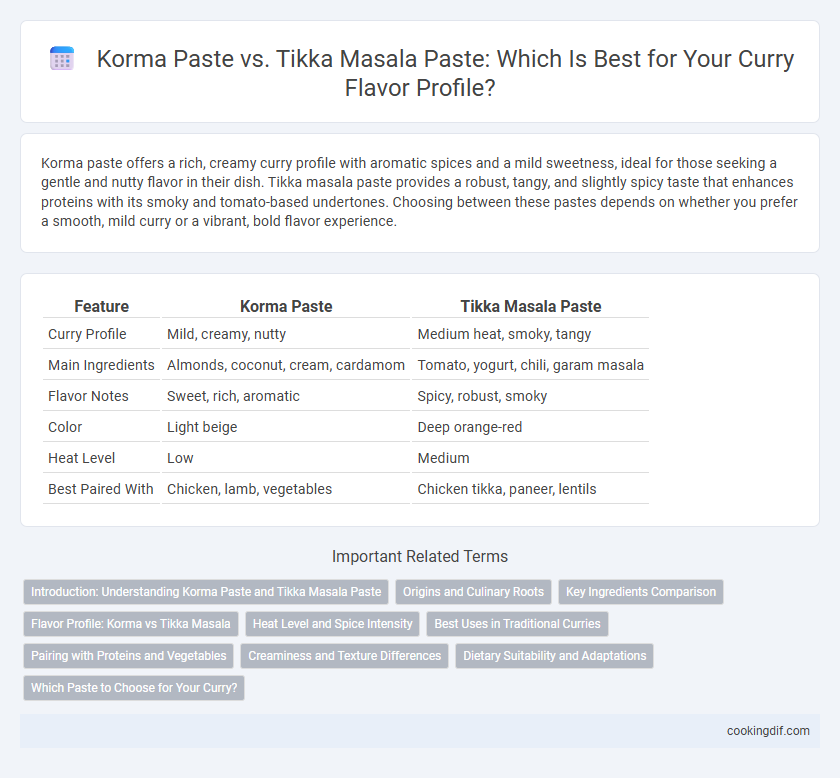Korma paste offers a rich, creamy curry profile with aromatic spices and a mild sweetness, ideal for those seeking a gentle and nutty flavor in their dish. Tikka masala paste provides a robust, tangy, and slightly spicy taste that enhances proteins with its smoky and tomato-based undertones. Choosing between these pastes depends on whether you prefer a smooth, mild curry or a vibrant, bold flavor experience.
Table of Comparison
| Feature | Korma Paste | Tikka Masala Paste |
|---|---|---|
| Curry Profile | Mild, creamy, nutty | Medium heat, smoky, tangy |
| Main Ingredients | Almonds, coconut, cream, cardamom | Tomato, yogurt, chili, garam masala |
| Flavor Notes | Sweet, rich, aromatic | Spicy, robust, smoky |
| Color | Light beige | Deep orange-red |
| Heat Level | Low | Medium |
| Best Paired With | Chicken, lamb, vegetables | Chicken tikka, paneer, lentils |
Introduction: Understanding Korma Paste and Tikka Masala Paste
Korma paste features a rich blend of aromatic spices like cardamom, cinnamon, and nutmeg combined with creamy ingredients such as yogurt or ground nuts, creating a mild, subtly sweet curry profile. Tikka masala paste offers a robust, spiced flavor with key ingredients including paprika, garam masala, and tomato puree, delivering a vibrant, smoky, and tangy taste. Understanding the distinct spice compositions and flavor bases helps in selecting the ideal paste for authentic Indian curry dishes.
Origins and Culinary Roots
Korma paste, originating from the Mughlai cuisine of North India, is characterized by its rich, creamy texture achieved with yogurt, nuts, and aromatic spices like cardamom and cinnamon, reflecting its royal culinary roots. Tikka masala paste, believed to have been developed in the United Kingdom, combines vibrant spices such as cumin, coriander, and paprika to create a smoky, tangy flavor profile that adapts traditional Indian flavors for Western palates. These pastes represent distinct curry profiles, with Korma emphasizing subtlety and creaminess, while Tikka Masala offers a robust, spiced intensity.
Key Ingredients Comparison
Korma paste typically features a blend of ground almonds, yogurt, coconut, and mild spices like cardamom, cinnamon, and cloves, creating a creamy, subtly sweet flavor profile. Tikka masala paste contains robust spices such as garam masala, cumin, coriander, turmeric, and smoked paprika, delivering a smoky, tangy, and moderately spicy taste. The key ingredient difference lies in Korma's emphasis on creamy, nutty elements versus Tikka Masala's vibrant, spice-forward, and slightly smoky character.
Flavor Profile: Korma vs Tikka Masala
Korma paste features a mild, creamy flavor profile with rich notes from ingredients like yogurt, coconut, and ground nuts, creating a subtly sweet and aromatic curry base. In contrast, tikka masala paste is robust and spicier, combining tomato puree, garam masala, and chili for a tangy, smoky, and vibrant curry experience. The choice between korma and tikka masala paste significantly impacts the curry's character, balancing between smooth sweetness and bold heat.
Heat Level and Spice Intensity
Korma paste offers a mild heat level with a creamy, nutty spice intensity, making it ideal for those who prefer subtle warmth in their curry. In contrast, tikka masala paste delivers a moderate to high heat level combined with robust, smoky spices that create a more intense and layered flavor profile. Choosing between korma and tikka masala paste depends on the desired balance of spice and heat in the curry dish.
Best Uses in Traditional Curries
Korma paste, rich with almonds, coconut, and aromatic spices, is best used in mild, creamy curries such as chicken korma and vegetable korma, enhancing dishes with a delicate, slightly sweet flavor. Tikka masala paste features robust spices, tomatoes, and cream, perfect for bold, vibrant curries like chicken tikka masala and paneer tikka, delivering a rich, tangy, and spicy profile. Both pastes are essential in traditional Indian cooking, with korma paste suited for subtle, creamy dishes and tikka masala paste ideal for intense, flavorful meat or vegetarian curries.
Pairing with Proteins and Vegetables
Korma paste, rich in aromatic spices like cardamom, cinnamon, and coconut, pairs exceptionally well with tender proteins such as chicken, lamb, and paneer, enhancing creamy vegetable sides like peas, carrots, and potatoes. Tikka masala paste, characterized by robust flavors of tomato, cumin, and garam masala, complements grilled proteins including chicken, shrimp, and beef, while balancing well with vegetables like bell peppers, onions, and spinach. Selecting the paste depends on desired flavor intensity and the texture of both proteins and vegetables used in the curry dish.
Creaminess and Texture Differences
Korma paste creates a rich, creamy curry profile with a smooth, velvety texture due to its blend of ground nuts, yogurt, and aromatic spices. Tikka masala paste, on the other hand, offers a moderately creamy texture with a thicker, chunkier consistency, emphasizing tomato and smoky spices. The creaminess in korma is more pronounced and luxurious, while tikka masala balances creaminess with a robust, hearty bite.
Dietary Suitability and Adaptations
Korma paste is typically milder and creamier, often suitable for vegetarian and gluten-free diets due to its use of nuts, cream, and aromatic spices. Tikka masala paste contains more robust spices and sometimes dairy or additives, requiring careful label checks for vegans or those with allergies. Both pastes can be adapted by substituting ingredients like coconut milk for cream or using gluten-free thickeners to accommodate dietary restrictions without compromising curry flavor.
Which Paste to Choose for Your Curry?
Korma paste offers a mild, creamy base with aromatic spices like cardamom, cinnamon, and coriander, ideal for rich, subtly flavored curries. Tikka masala paste provides a robust, tangy profile with tomato, garlic, and chili, perfect for vibrant, spicy dishes. Choose korma paste for delicate, comforting curries and tikka masala paste for bold, intense flavors.
Korma paste vs tikka masala paste for curry profile Infographic

 cookingdif.com
cookingdif.com